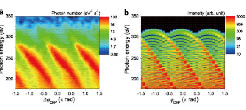Generation of Attosecond Soft-X-Ray Bursts in the Water Window
Itatani Group
High harmonic generation using intense laser pulses is the most promising method to produce attosecond optical pulses. In the past decade, attosecond science has been extensively exploited using the advanced Ti:sapphire laser technology that can produce attosecond pulses in the extreme ultraviolet (EUV) below 200 eV in photon energies. Recent development of intense infrared sources that are based on optical parametric chirped-pulse amplification (OPCPA) has opened the opportunities to extend the spectral range of high harmonics from the EUV to the soft X ray region, but the lack of well-controlled reliable IR sources has been the problem to realize attosecond soft-X-ray spectroscopy.

Fig. 1. (a) Experimentally obtained high harmonic spectra recorded at relative carrier-envelope phases in steps of 0.1π rad. (b) Simulated high harmonic spectra assuming 10-fs optical pulses at 1600 nm with an intensity of 4 × 1014 W/cm2.
In the present research [1], we have developed a novel IR light source that is based on OPCPA using BiB3O6 crystals pumped by Ti:sapphire lasers. This OPCPA system can amplify an octave-spanned bandwidth from 1100 to 2200 nm, which enables the phase-stable direct amplification of sub-two-cycle IR pulses. The light source produces 0.5-mJ, 9-fs pulses with stable carrier-envelope phases (CEPs) at 1-kHz repetition rate. We have achieved excellent stabilities in the output energy and CEP, which are comparable to those of commercial Ti:sapphire lasers.
Figure 1(a) shows observed high harmonic spectra around the cutoff photon energy as a function of the CEP. The maximum photon energy reaches ~330 eV that is well beyond the carbon K edge at 284 eV. The shifting structures of the spectral peak is called the half-cycle cutoff, which is a clear signature of the generation of single isolated attosecond pulses. Figure 1(b) shows simulated results that are based on the strong-field approximation assuming the experimental parameters described in the caption of Fig. 1(a). The good agreement between the experimental and simulation results suggests the generation of isolated attosecond bursts in the water window. This result is an important milestone to extend the attosecond spectroscopy into the soft X ray region where element-specific ultrafast spectroscopy as well as novel attosecond techniques using high-energy electron wavepackets can be explored in the future.
References
- [1] N. Ishii, K. Kaneshima, K. Kitano, T. Kanai, S. Watanabe, and J. Itatani, Nature Comm. 5, 3331 (2014).
